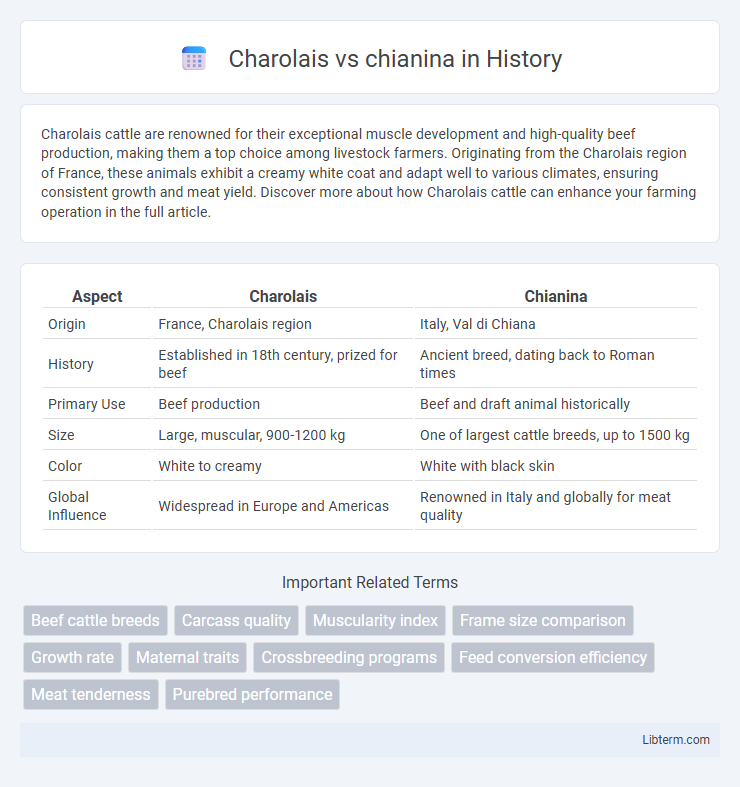Charolais cattle are renowned for their exceptional muscle development and high-quality beef production, making them a top choice among livestock farmers. Originating from the Charolais region of France, these animals exhibit a creamy white coat and adapt well to various climates, ensuring consistent growth and meat yield. Discover more about how Charolais cattle can enhance your farming operation in the full article.
Table of Comparison
| Aspect | Charolais | Chianina |
|---|---|---|
| Origin | France, Charolais region | Italy, Val di Chiana |
| History | Established in 18th century, prized for beef | Ancient breed, dating back to Roman times |
| Primary Use | Beef production | Beef and draft animal historically |
| Size | Large, muscular, 900-1200 kg | One of largest cattle breeds, up to 1500 kg |
| Color | White to creamy | White with black skin |
| Global Influence | Widespread in Europe and Americas | Renowned in Italy and globally for meat quality |
Overview of Charolais and Chianina Breeds
Charolais is a French cattle breed prized for its muscular build, rapid growth, and high-quality beef production, characterized by its creamy white coat and strong adaptability to various climates. Chianina, originating from Italy, is one of the oldest and largest cattle breeds, renowned for its lean meat, exceptional size, and striking white coat with black skin pigmentation. Both breeds are highly valued in the beef industry, with Charolais favored for marbling and tenderness, while Chianina is noted for its lean protein and traditional use in Italian cuisine.
Origin and Historical Background
Charolais cattle originate from the Charolais region in eastern France, where selective breeding began in the 18th century to enhance their size and meat quality. Chianina cattle trace their roots to the Val di Chiana in Tuscany, Italy, with a history dating back over 2,000 years as one of the oldest and largest cattle breeds used originally for draft purposes before their reputation for beef excellence. Both breeds have been integral to their regions' agricultural heritage, influencing meat production standards and local economies.
Physical Characteristics Comparison
Charolais cattle exhibit a muscular build with a broad body, creamy white coat, and a height averaging 56-60 inches at the shoulder, known for rapid growth and heavy muscling. Chianina cattle are taller, standing around 60-70 inches at the shoulder, characterized by their lean, white coat with black skin pigmentation around the eyes and muzzle, and a more elongated frame adapted for endurance. Both breeds display strong physical traits suited to beef production, but Charolais emphasizes mass and muscle volume while Chianina combines height and leanness.
Growth Rate and Maturity
Charolais cattle exhibit a rapid growth rate, typically reaching market weight faster than many breeds, making them ideal for efficient beef production. Chianina cattle, known for their impressive size, mature more slowly but develop substantial muscle mass and frame over time. Growth efficiency in Charolais often translates to earlier slaughter age, while Chianina's extended maturity period contributes to their larger final body size.
Meat Quality and Yield
Charolais cattle are renowned for their high meat yield with superior marbling and tenderness, making their beef prized for flavor and juiciness. Chianina cattle, one of the oldest and largest breeds, produce leaner meat with less intramuscular fat, resulting in a firmer texture and lower fat content. While Charolais offers a better balance of meat quality and quantity, Chianina is favored for lean, protein-rich cuts with enhanced muscle yield.
Adaptability to Various Environments
Charolais cattle exhibit strong adaptability to diverse climates, thriving in both temperate and harsh environments due to their robust constitution and efficient feed conversion. Chianina cattle, originating from Italy, are highly resilient in hot climates and well-suited to extensive grazing systems, showing exceptional tolerance to heat and drought conditions. Both breeds demonstrate notable environmental adaptability, but Charolais tend to perform better in colder regions while Chianina excel in Mediterranean and arid zones.
Temperament and Handling
Charolais cattle are known for their calm temperament and ease of handling, making them suitable for both beginner and experienced farmers. Chianina cattle, while generally docile, can exhibit a more spirited and independent nature, requiring handlers to be more attentive and experienced with large, strong breeds. Proper handling techniques and regular interaction help maintain manageable behavior in both breeds.
Breeding and Reproductive Performance
Charolais cattle are renowned for their muscular build and efficient growth rates, making them highly favorable in breeding programs focused on meat production. Chianina cattle exhibit exceptional reproductive performance, including high fertility rates and ease of calving, attributed to their long-established genetic adaptability in harsh environments. Both breeds demonstrate strong maternal instincts, but Chianina often shows longer reproductive longevity compared to Charolais.
Economic Value in Beef Production
Charolais cattle are renowned for their rapid growth rates and high yield of lean, tender beef, making them economically valuable for intensive beef production systems. Chianina cattle, one of the largest and oldest breeds, provide exceptional carcass weights and favorable feed efficiency, offering significant profitability for producers focusing on premium beef markets. Both breeds contribute substantially to global beef industry economics through their distinct advantages in meat quality and production efficiency.
Choosing the Right Breed: Charolais or Chianina?
Charolais cattle are renowned for their rapid growth, muscular build, and high-quality marbled beef, making them ideal for producers prioritizing efficient meat yield and tenderness. Chianina, one of the oldest and largest cattle breeds, offers exceptional lean meat with low fat content, favored for health-conscious consumers and premium steak cuts. Selecting Charolais or Chianina depends on whether the focus is on faster growth and marbling or leaner beef with traditional heritage appeal.
Charolais Infographic

 libterm.com
libterm.com